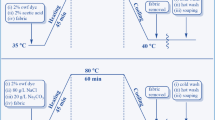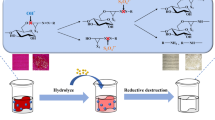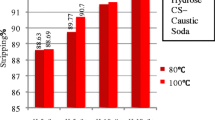Abstract
Developing mild decolorization technology is critical for accomplishing clean pulping to overcome issues of the severe degradation of cellulose during the preparation of cotton pulp from waste cotton textiles and the high energy consumed in this preparation. The sodium hydroxide (NaOH)-sodium dithionite (Na2S2O4) system is widely used for decolorizing cotton fabrics. However, previous reports have only studied decolorizing cotton fabrics using this hybrid system and did not clarify the decolorization mechanism of NaOH and Na2S2O4 on fabric dyed with different types of reactive dyes. Therefore, in this work, according to the chromophore groups and active groups of the reactive dyes, the decolorization of cotton fibers dyed with azo monochlorotriazine reactive dyes, anthraquinone vinyl sulfone reactive dyes and diazobismonochlorotriazine reactive dyes was studied. The decolorization mechanism of NaOH and Na2S2O4 on cotton fabrics dyed with different types of reactive dyes was clarified by employing NaOH and Na2S2O4 separately and in combination. Fourier transform infrared spectroscopy, X-ray diffractometer and extension testing were used to explore the effects of decolorization on the chemical structure, crystalline structure, and physical and mechanical properties of cotton fabrics. This work provides a theoretical basis for the decolorization of cotton fabrics dyed using different reactive dyes.
Graphic abstract













Similar content being viewed by others
References
Arooj F, Ahmad N, Chaudhry MN (2015) A pilot-scale application of ozone to bleach raw cotton fabric using various additives. Ozone-Sci Eng 37:203–215. https://doi.org/10.1080/01919512.2014.956861
Athanasopoulos P, Zabaniotou A (2022) Post-consumer textile thermochemical recycling to fuels and biocarbon: a critical review. Sci Total Environ 834:14. https://doi.org/10.1016/j.scitotenv.2022.155387
Cao HT, Cobb K, Yatvitskiy M, Wolfe M, Shen HQ (2022) Textile and product development from end-of-use cotton apparel: a study to reclaim value from waste. Sustainability 14:20. https://doi.org/10.3390/su14148553
Chen SL, Lu SS, Wei LL, Yao YY, Chen WX (2007) Study on decoloration of reactive dye by chlorine dioxide. J Text Res 28:68–71
Choe EK, Lee M, Park KS, Chung C (2019) Characterization of cotton fabric scouring by Fourier transform-infrared attenuated total reflectance spectroscopy, gas chromatography-mass spectrometry and water absorption measurements. Text Res J 89:2305–2315. https://doi.org/10.1177/0040517518790976
Chung C, Lee M, Choe EK (2004) Characterization of cotton fabric scouring by FT-IR ATR spectroscopy. Carbohyd Polym 58:417–420. https://doi.org/10.1016/j.carbpol.2004.08.005
Dahlbo H, Aalto K, Eskelinen H, Salmenpera H (2017) Increasing textile circulation-consequences and requirements. Sustain Prod Consum 9:44–57. https://doi.org/10.1016/j.spc.2016.06.005
El-Sakhawy M (2005) Effect of bleaching sequence on paper ageing. Polym Degrad Stab 87:419–423. https://doi.org/10.1016/j.polymdegradstab.2004.10.002
French AD (2014) Idealized powder diffraction patterns for cellulose polymorphs. Cellulose 21:885–896. https://doi.org/10.1007/s10570-013-0030-4
He FN, Li X, Zhu MK, Hu JH, Yuan YJ, Li CC, Long JJ (2019) Color stripping of reactive-dyed cotton fabric in a UV/sodium hydrosulfite system with a dipping manner at low temperature. Cellulose 26:4125–4142. https://doi.org/10.1007/s10570-019-02336-w
He JM, Xie CF, Long JJ (2021) Sustainable color stripping of cotton substrate dyed with reactive dyes in a developed UV/K2S2O8 photocatalytic system. J Taiwan Inst Chem Eng 121:241–256. https://doi.org/10.1016/j.jtice.2021.04.023
Jiang XY, Zhao ZY, Liao YX, Tang CC, Tremblay PL, Zhang T (2022) A recyclable colorimetric sensor made of waste cotton fabric for the detection of copper ions. Cellulose 29:5103–5115. https://doi.org/10.1007/s10570-022-04572-z
Leal W, Ellams D, Han S, Tyler D, Boiten VJ, Paco A, Moora H, Balogun AL (2019) A review of the socio-economic advantages of textile recycling. J Clean Prod 218:10–20. https://doi.org/10.1016/j.jclepro.2019.01.210
Li RJ, Yang JJ, Zhang GQ, Zhu P (2022) Decolorization of dark-colored waste cotton fabric using redox decoloring agents. RSC Adv 12:17689–17700. https://doi.org/10.1039/d2ra02071h
Long JJ, Liu B, Wang GF, Shi W (2017) Photocatalitic stripping of fixed reactive red X-3B dye from cotton with nano-TiO2/UV system. J Clean Prod 165:788–800. https://doi.org/10.1016/j.jclepro.2017.07.149
Lopatina A, Anugwom I, Blot H, Conde AS, Manttari M, Kallioinen M (2021) Re-use of waste cotton textile as an ultrafiltration membrane. J Environ Chem Eng 9:7. https://doi.org/10.1016/j.jece.2021.105705
Lu L, Fan W, Meng X, Xue L, Ge S, Wang C, Foong SY, Tan CSY, Sonne C, Aghbashlo M et al (2022) Current recycling strategies and high value utilization of waste cotton. The Science of the total environment. https://doi.org/10.1016/j.scitotenv.2022.158798
Malkavaara P, Isoaho JP, Alen R, Soininen J (2000) Dithionite bleaching of thermomechanical pulp: factors having effects on bleaching efficiency. J Chemom 14:693–698. https://doi.org/10.1002/1099-128x(200009/12)14:5/6%3c693::Aid-cem612%3e3.0.Co;2-7
Pensupa N, Leu SY, Hu YZ, Du CY, Liu H, Jing HD, Wang HM, Lin CSK (2017) Recent trends in sustainable textile waste recycling methods: current situation and future prospects. Top Curr Chem 375:40. https://doi.org/10.1007/s41061-017-0165-0
Ribul M, Lanot A, Pisapia CT, Purnell P, McQueen-Mason SJ, Baurley S (2021) Mechanical, chemical, biological: moving towards closed-loop bio-based recycling in a circular economy of sustainable textiles. J Clean Prod 326:13. https://doi.org/10.1016/j.jclepro.2021.129325
Sharma K, Khilari V, Chaudhary BU, Jogi AB, Pandit AB, Kale RD (2020) Cotton based composite fabric reinforced with waste polyester fibers for improved mechanical properties. Waste Manage 107:227–234. https://doi.org/10.1016/j.wasman.2020.04.011
Uddin MG, Islam MM, Islam MR (2015) Effects of reductive stripping of reactive dyes on the quality of cotton fabric. Fash Text 2:1–12. https://doi.org/10.1186/s40691-015-0032-y
Wang C, Li YZ, Yu HY, Abdalkarim SYH, Zhou JP, Yao JM, Zhang LN (2021) Continuous meter-scale wet-spinning of cornlike composite fibers for eco-friendly multifunctional electronics. ACS Appl Mater Interfaces 13:40953–40963. https://doi.org/10.1021/acsami.1c12012
Xie C, Liu B, Sun J, Tang R, Long J (2017) Photocatalytic color stripping of cotton fabric dyed with reactive dye by employing UV/H2O systerm. J Text Res 38:81–88. https://doi.org/10.13475/j.fzxb.20170100308
Zhu CH, Shi J, Xu SJ, Ishimori M, Sui JH, Morikawa H (2017) Design and characterization of self-cleaning cotton fabrics exploiting zinc oxide nanoparticle-triggered photocatalytic degradation. Cellulose 24:2657–2667. https://doi.org/10.1007/s10570-017-1289-7
Acknowledgments
These works were supported by the National Key Research and Development Project “Solid Waste Recycling” Earmarked Project of China (No. 2020YFC1910301)
Author information
Authors and Affiliations
Contributions
WW has done the main job of this study. WW was responsible for investigation, data curation, and original draft. YY was responsible for review and editing. ZX, HW, XG, ZG and PZ were responsible for methodology and investigation. CZ was responsible for conceptualization, methodology, supervision, and funding acquisition. All authors read, revised, and approved the final manuscript.
Corresponding author
Ethics declarations
Competing interest
The authors declare no competing interest.
Additional information
Publisher's Note
Springer Nature remains neutral with regard to jurisdictional claims in published maps and institutional affiliations.
Rights and permissions
Springer Nature or its licensor (e.g. a society or other partner) holds exclusive rights to this article under a publishing agreement with the author(s) or other rightsholder(s); author self-archiving of the accepted manuscript version of this article is solely governed by the terms of such publishing agreement and applicable law.
About this article
Cite this article
Wang, W., Xu, Z., Yin, Y. et al. Decolorization properties and mechanism of reactive-dyed cotton fabrics with different structures utilized to prepare cotton pulp. Cellulose 30, 4735–4748 (2023). https://doi.org/10.1007/s10570-023-05153-4
Received:
Accepted:
Published:
Issue Date:
DOI: https://doi.org/10.1007/s10570-023-05153-4




